Electromagnetic Interference Shielding Behavior of Magnetic Carbon Fibers Prepared by Electroless FeCoNi-Plating
Abstract
:1. Introduction
2. Experimental
2.1. Specimen Preparation
2.2. Characterization
3. Results and Discussion
4. Conclusions
Author Contributions
Funding
Institutional Review Board Statement
Informed Consent Statement
Data Availability Statement
Acknowledgments
Conflicts of Interest
References
- Luo, X.; Chung, D.D.L. Electromagnetic interference shielding using continuous carbon-fiber carbon-matrix and polymer-matrix composites. Compos. Part B Eng. 1999, 30, 227–231. [Google Scholar] [CrossRef]
- Thomassin, J.M.; Jerome, C.; Pardoen, T.; Bailly, C.; Huynen, I.; Detrembleur, C. Polymer/carbon based composites as electromagnetic interference (EMI) shielding materials. Mater. Sci. Eng. R Rep. 2013, 74, 211–232. [Google Scholar] [CrossRef]
- Zeranska-Chudek, K.; Siemion, A.; Palka, A.; Mdarhri, A.; Elaboudi, I.; Brosseau, C.; Zdrojek, M. Terahertz shielding properties of carbon black based polymer nanocomposites. Materials 2021, 13, 738. [Google Scholar]
- Fan, Z.; Liu, R.; Cheng, X. Preparation and characterization of electromagnetic shielding composites based on graphene-nanosheets-loaded nonwoven fabric. Coatings 2021, 11, 424. [Google Scholar] [CrossRef]
- Park, S.H.; Ha, J.H. Improved electromagnetic interference shielding properties through the use of segregate carbon nanotube networks. Materials 2019, 12, 1395. [Google Scholar] [CrossRef] [PubMed] [Green Version]
- He, P.; Cao, M.S.; Cai, Y.Z.; Shu, J.C.; Cao, W.Q.; Yuan, J. Self-assembling flexible 2D carbide MXene film with tunable integrated electron migration and group relaxation toward energy storage and green EMI shielding. Carbon 2020, 157, 80–89. [Google Scholar] [CrossRef]
- Pusic, T.; Saravanja, B.; Malaric, K. Electromagnetic shielding properties of knitted fabric made from polyamide threads coated with silver. Materials 2021, 14, 1281. [Google Scholar] [CrossRef] [PubMed]
- Sridhar, V.; Lee, I.; Park, H. Metal Organic Frameworks Derived Fe-NC Nanostructures as High-Performance Electrodes for Sodium Ion Batteries and Electromagnetic Interference (EMI) Shielding. Molecules 2021, 26, 1018. [Google Scholar] [CrossRef] [PubMed]
- Wang, X.X.; Shu, J.C.; Cao, W.Q.; Zhang, M.; Yuan, J.; Cao, M.S. Eco-mimetic nanoarchitecture for green EMI shielding. Chem. Eng. J. 2019, 369, 1068–1077. [Google Scholar] [CrossRef]
- Zha, X.J.; Pu, J.H.; Ma, L.F.; Li, T.; Bao, R.Y.; Bai, L.; Liu, Z.Y.; Yang, M.B.; Yang, W. A particular interfacial strategy in PVDF/OBC/MWCNT nanocomposites for high dielectric performance and electromagnetic interference shielding. Compos. Part A Appl. Sci. Manuf. 2018, 105, 118–125. [Google Scholar] [CrossRef]
- Lu, D.; Mo, Z.; Liang, B.; Yang, L.; He, Z.; Zhu, H.; Tang, Z.; Gui, Z. Flexible, lightweight carbon nanotube sponges and composites for high-performance electromagnetic interference shielding. Carbon 2018, 133, 457–463. [Google Scholar] [CrossRef]
- Agrawal, P.R.; Kumar, R.; Teotia, S.; Kumari, S.; Mondal, D.P.; Dhakate, S.R. Lightweight, high electrical and thermal conducting carbon-rGO composites foam for superior electromagnetic interference shielding. Compos. Part B Eng. 2019, 160, 131–139. [Google Scholar] [CrossRef]
- Yu, W.C.; Xu, J.Z.; Wang, Z.G.; Huang, Y.F.; Yin, H.M.; Xu, L.; Chen, Y.W.; Yan, D.X.; Li, Z.M. Constructing highly oriented segregated structure towards high-strength carbon nanotube/ultrahigh-molecular-weight polyethylene composites for electromagnetic interference shielding. Compos. Part A Appl. Sci. Manuf. 2018, 110, 237–245. [Google Scholar] [CrossRef]
- Lee, S.H.; Yu, S.; Shahzad, F.; Hong, J.; Noh, S.J.; Kim, W.N.; Hong, S.M.; Koo, C.M. Low percolation 3D Cu and Ag shell network composites for EMI shielding and thermal conduction. Compos. Sci. Technol. 2019, 182, 107778. [Google Scholar] [CrossRef]
- Hong, X.; Chung, D.D.L. Carbon nanofiber mats for electromagnetic interference shielding. Carbon 2017, 111, 529–537. [Google Scholar] [CrossRef]
- Yim, Y.J.; Baek, Y.M.; Park, S.J. Influence of Nickel Layer on Electromagnetic Interference Shielding Effectiveness of CuS-Polyacrylonitrile Fibers. Bull. Korean Chem. Soc. 2018, 39, 1406–1411. [Google Scholar] [CrossRef]
- Jia, L.C.; Yan, D.X.; Yang, Y.; Zhou, D.; Cui, C.H.; Bianco, E.; Lou, J.; Vajtai, R.; Li, B.; Ajayan, P.M.; et al. High strain tolerant EMI shielding using carbon nanotube network stabilized rubber composite. Adv. Mater. Technol. 2017, 2, 1700078. [Google Scholar] [CrossRef]
- Yim, Y.J.; Park, S.J. Effect of silver-plated expanded graphite addition on thermal and electrical conductivities of epoxy composites in the presence of graphite and copper. Compos. Part A Appl. Sci. Manuf. 2019, 123, 253–259. [Google Scholar] [CrossRef]
- Yang, G.; Yim, Y.J.; Lee, J.W.; Heo, Y.J.; Park, S.J. Carbon-Filled Organic Phase-Change Materials for Thermal Energy Storage: A Review. Molecules 2019, 24, 2055. [Google Scholar] [CrossRef] [Green Version]
- Xing, D.; Lu, L.; The, K.S.; Wan, Z.; Xie, Y.; Tang, Y. Highly flexible and ultra-thin Ni-plated carbon-fabric/polycarbonate film for enhanced electromagnetic interference shielding. Carbon 2018, 132, 32–41. [Google Scholar] [CrossRef]
- Yim, Y.J.; Rhee, K.Y.; Park, S.J. Electromagnetic interference shielding effectiveness of nickel-plated MWCNTs/high-density polyethylene composites. Compos. Part B Eng. 2016, 98, 120–125. [Google Scholar] [CrossRef]
- Rahaman, M.; Chaki, T.K.; Khastgir, D. High-performance EMI shielding materials based on short carbon fiber-filled ethylene vinyl acetate copolymer, acrylonitrile butadiene copolymer, and their blends. Polym. Compos. 2011, 32, 1790–1805. [Google Scholar] [CrossRef]
- Xing, D.; Lu, L.; Tang, W.; Xie, Y.; Tang, Y. An ultra-thin multilayer carbon fiber reinforced composite for absorption-dominated EMI shielding application. Mater. Lett. 2017, 207, 165–168. [Google Scholar] [CrossRef]
- Yim, Y.J.; Park, S.J. Electromagnetic interference shielding effectiveness of high-density polyethylene composites reinforced with multi-walled carbon nanotubes. J. Ind. Eng. Chem. 2015, 21, 155–157. [Google Scholar] [CrossRef]
- Chen, J.; Wu, J.; Ge, H.; Zhao, D.; Liu, C.; Hong, X. Reduced graphene oxide deposited carbon fiber reinforced polymer composites for electromagnetic interference shielding. Compos. Part A Appl. Sci. Manuf. 2016, 82, 141–150. [Google Scholar] [CrossRef]
- Jia, Y.; Li, K.; Xue, L.; Ren, J.; Zhang, S.; Li, H. Mechanical and electromagnetic shielding performance of carbon fiber reinforced multilayered (PyC-SiC) n matrix composites. Carbon 2017, 111, 299–308. [Google Scholar] [CrossRef]
- Yim, Y.J.; Chung, D.C.; Park, S.J. EMI shielding effectiveness and mechanical properties of MWCNTs-reinforced biodegradable epoxy matrix composites. Carbon Lett. 2017, 22, 36–41. [Google Scholar]
- Mei, H.; Han, D.; Xiao, S.; Ji, T.; Tang, J.; Cheng, L. Improvement of the electromagnetic shielding properties of C/SiC composites by electrophoretic deposition of carbon nanotube on carbon fibers. Carbon 2016, 109, 149–153. [Google Scholar] [CrossRef]
- Wong, K.H.; Pickering, S.J.; Rudd, C.D. Recycled carbon fibre reinforced polymer composite for electromagnetic interference shielding. Compos. Part A Appl. Sci. Manuf. 2010, 41, 693–702. [Google Scholar] [CrossRef]
- Huang, X.; Dai, B.; Ren, Y.; Xu, J.; Zhao, C. Controllable synthesis and electromagnetic interference shielding properties of magnetic CoNi alloy nanoparticles coated on biocarbon nanofibers. J. Mater. Sci. Mater. Electron. 2015, 26, 2584–2588. [Google Scholar] [CrossRef]
- Lee, S.H.; Kim, J.Y.; Koo, C.M.; Kim, W.N. Effects of processing methods on the electrical conductivity, electromagnetic parameters, and EMI shielding effectiveness of polypropylene/nickel-coated carbon fiber composites. Macromol. Res. 2017, 25, 936–943. [Google Scholar] [CrossRef]
- Hwang, S.S. Tensile, electrical conductivity and EMI shielding properties of solid and foamed PBT/carbon fiber composites. Compos. Part B Eng. 2016, 98, 1–8. [Google Scholar] [CrossRef]
- Yim, Y.J.; Bae, K.M.; Park, S.J. Influence of Oxyfluorination on Geometrical Pull-Out Behavior of Carbon-Fiber-Reinforced Epoxy Matrix Composites. Macromol. Res. 2018, 26, 794–799. [Google Scholar] [CrossRef]
- Kim, T.; Lee, J.; Lee, K.; Park, B.; Jung, B.M.; Lee, S.B. Magnetic and dispersible FeCoNi-graphene film produced without heat treatment for electromagnetic wave absorption. Chem. Eng. J. 2019, 361, 1182–1189. [Google Scholar] [CrossRef]
- Zhan, Y.; Long, Z.; Wan, X.; Zhang, J.; He, S.; He, Y. 3D carbon fiber mats/nano-Fe3O4 hybrid material with high electromagnetic shielding performance. Appl. Surf. Sci. 2018, 444, 710–720. [Google Scholar] [CrossRef]
- Zhan, Y.; Wang, J.; Zhamg, K.; Li, Y.; Meng, Y.; Yan, N.; Wei, W.; Peng, F.; Xia, H. Fabrication of a flexible electromagnetic interference shielding Fe3O4@ reduced graphene oxide/natural rubber composite with segregated network. Chem. Eng. J. 2018, 344, 184–193. [Google Scholar] [CrossRef]
- Lee, J.; Jung, B.M.; Lee, S.B.; Lee, S.K.; Kim, K.H. FeCoNi coated glass fibers in composite sheets for electromagnetic absorption and shielding behaviors. Appl. Surf. Sci. 2017, 415, 99–103. [Google Scholar] [CrossRef]
- Kamchi, N.E.; Belaabed, B.; Wojkiewicz, J.L.; Lamouri, S.; Lasri, T. Hybrid polyaniline/nanomagnetic particles composites: High performance materials for EMI shielding. J. Appl. Polym. Sci. 2013, 127, 4426–4432. [Google Scholar] [CrossRef]
- Cho, S.; Choi, J.R.; Jung, B.M.; Choi, U.H.; Lee, S.K.; Kim, K.H.; Le, S.B. Electro-magnetic properties of composites with aligned Fe-Co hollow fibers. AIP Adv. 2016, 6, 055920. [Google Scholar] [CrossRef] [Green Version]
- Kim, J.T.; Park, C.W.; Kim, B.J. A study on synergetic EMI shielding behaviors of Ni-Co alloy-coated carbon fibers-reinforced composites. Synth. Met. 2017, 223, 212–217. [Google Scholar] [CrossRef]
- Huang, C.Y.; Pai, J.F. Optimum conditions of electroless nickel plating on carbon fibres for EMI shielding effectiveness of ENCF/ABS composites. Eur. Polym. J. 1998, 34, 261–267. [Google Scholar] [CrossRef]
- Singh, S.; Bhatnagar, A.; Shukla, V.; Vishwakarma, A.; Soni, P.; Verma, S.; Shaz, M.; Sinha, A.; Srivastava, O. Ternary transition metal alloy FeCoNi nanoparticles on graphene as new catalyst for hydrogen sorption in MgH2. Int. J. Hydrog. Energy 2020, 45, 774–786. [Google Scholar] [CrossRef]
- Lee, S.Y.; Lee, C.H.; Hur, H.; Seo, J.; Lee, Y.J. Characterization of Synthesized Strontianite: Effects of Ionic Strength, Temperature, and Aging Time on Crystal Morphology and Size. J. Miner. Soc. Korea 2015, 28, 195–207. [Google Scholar] [CrossRef]
- Lee, K.; Lee, J.; Jung, B.M.; Lee, S.B.; Kim, T. Dispersion Characteristics of Magnetic Particle/Graphene Hybrid Based on Dispersant and Electromagnetic Interference Shielding Characteristics of Composites. Compos. Res. 2018, 31, 111–116. [Google Scholar]
- Kim, D.; Kim, J.; Lee, J.; Kang, M.K.; Kim, S.; Park, S.H.; Kim, J.; Choa, Y.H.; Lim, J.H. Enhanced Magnetic Properties of FeCo Alloys by Two-Step Electroless Plating. J. Electrochem. Soc. 2019, 166, D131–D136. [Google Scholar] [CrossRef]
- Yim, Y.J.; Heo, Y.J.; Park, S.J. Effect of electroless nickel plating on electromagnetic interference shielding effectiveness of pitch-based carbon papers/epoxy composites. Funct. Compos. Struct. 2019, 1, 035001. [Google Scholar] [CrossRef]
- Cao, W.; Ma, C.; Tan, S.; Ma, M.; Wan, P.; Chen, F. Ultrathin and Flexible CNTs/MXene/Cellulose Nanofibrils Composite Paper for Electromagnetic Interference Shielding. Nano-Micro Lett. 2019, 11, 72. [Google Scholar] [CrossRef] [Green Version]
- Wang, R.; He, F.; Wan, Y.; Qi, Y. Preparation and characterization of a kind of magnetic carbon fibers used as electromagnetic shielding materials. J. Alloys Compd. 2012, 514, 35–39. [Google Scholar] [CrossRef]
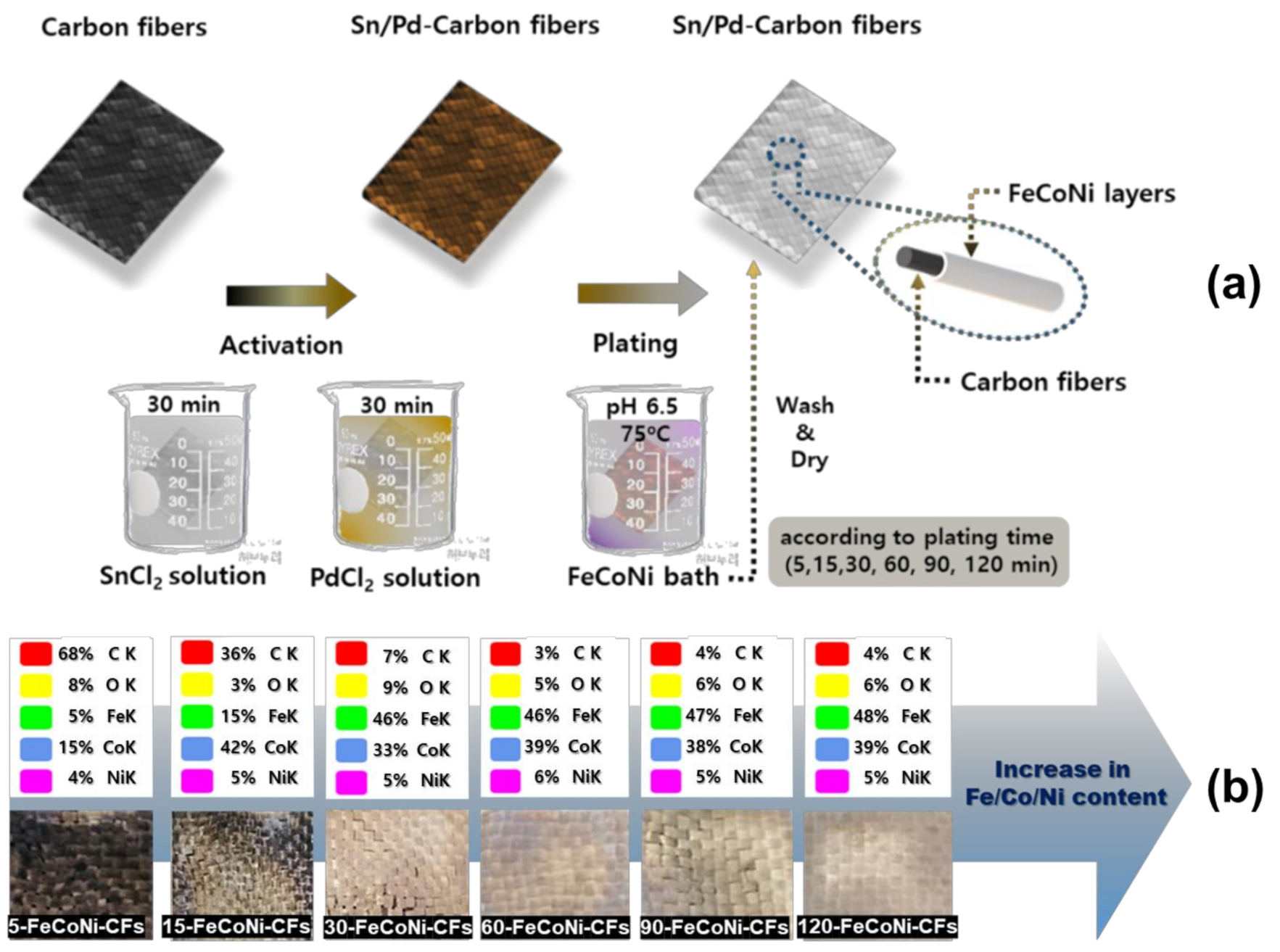
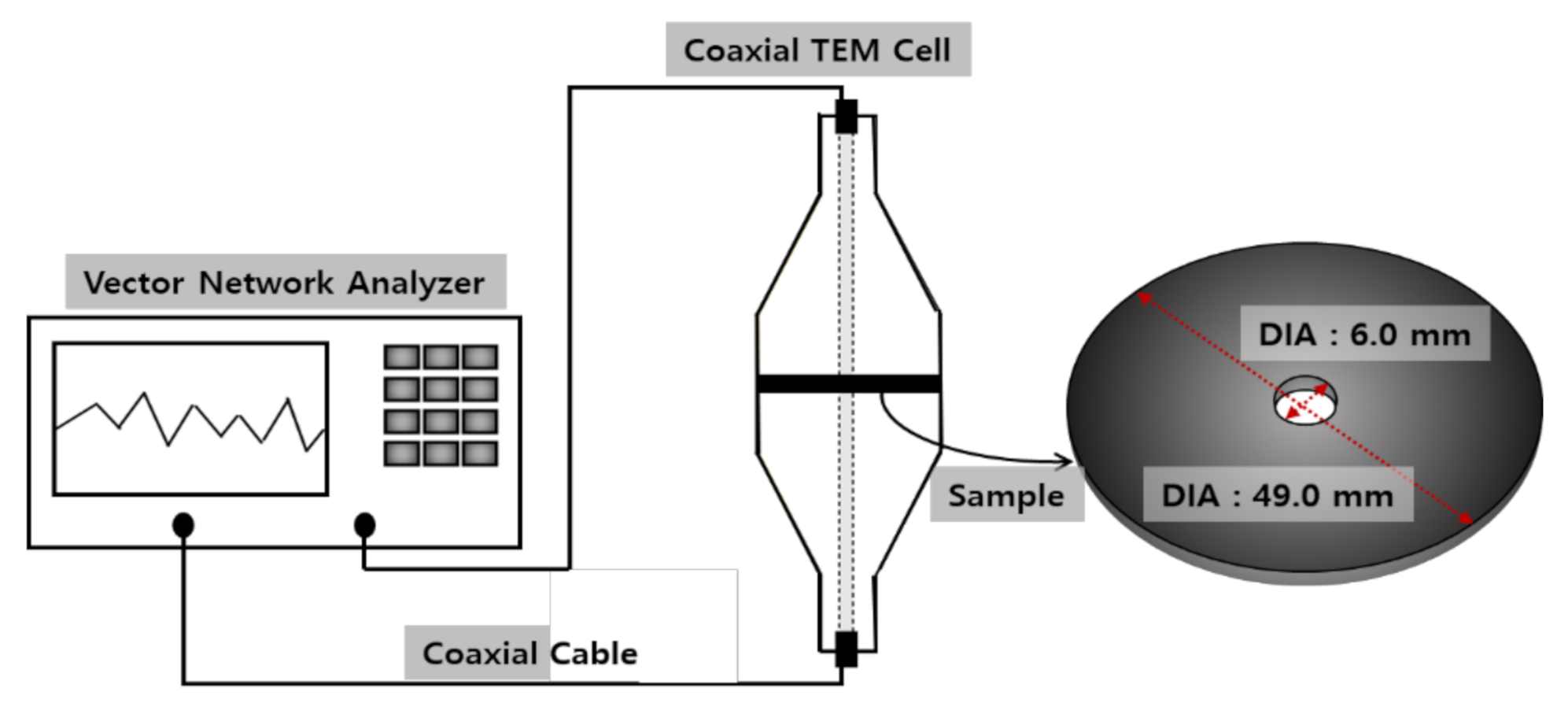
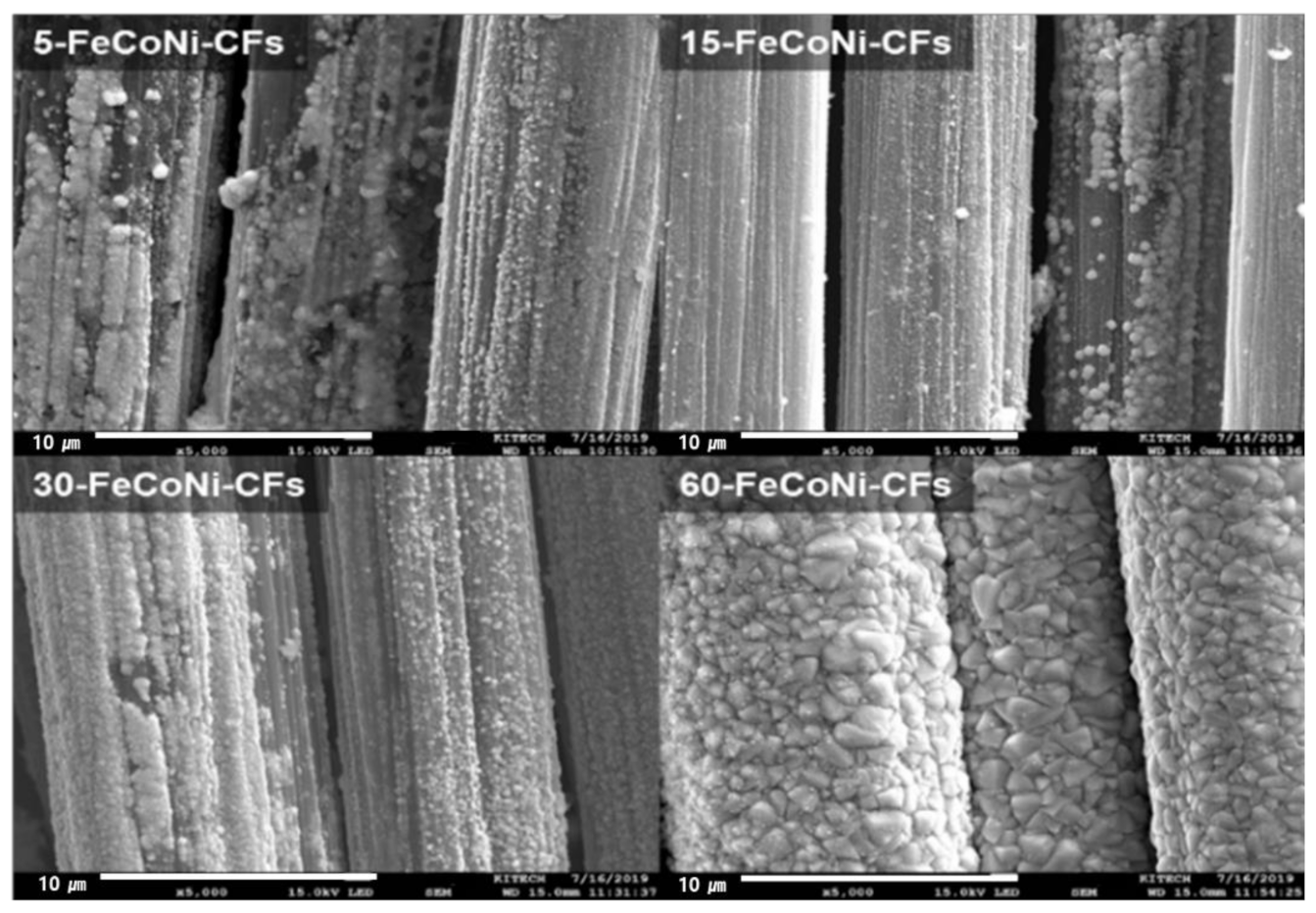
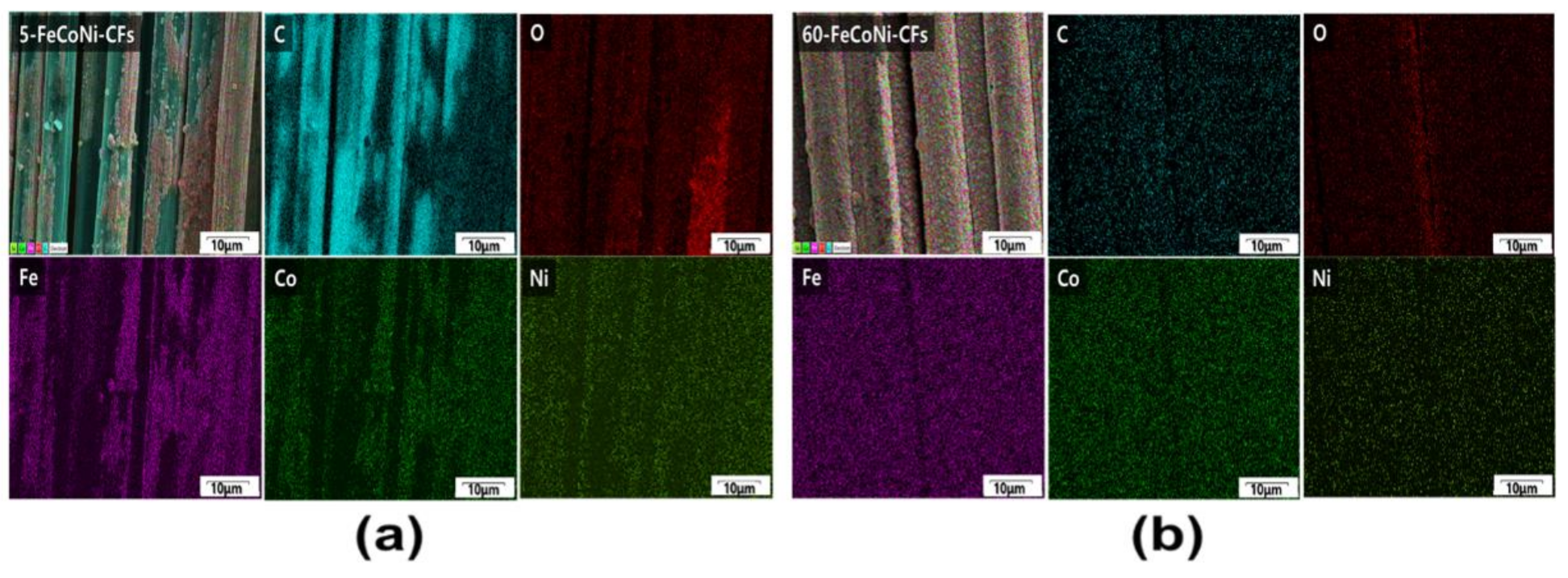
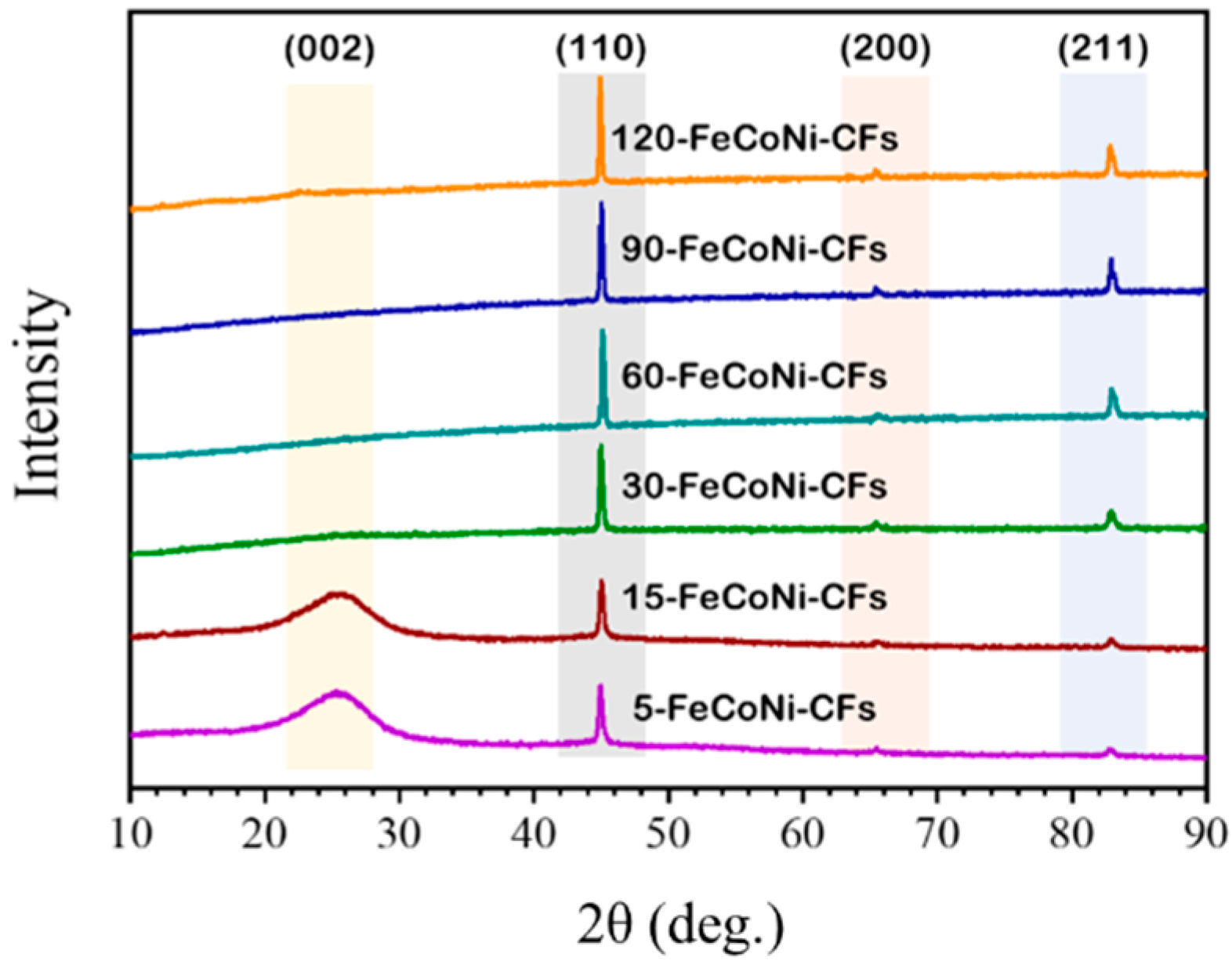

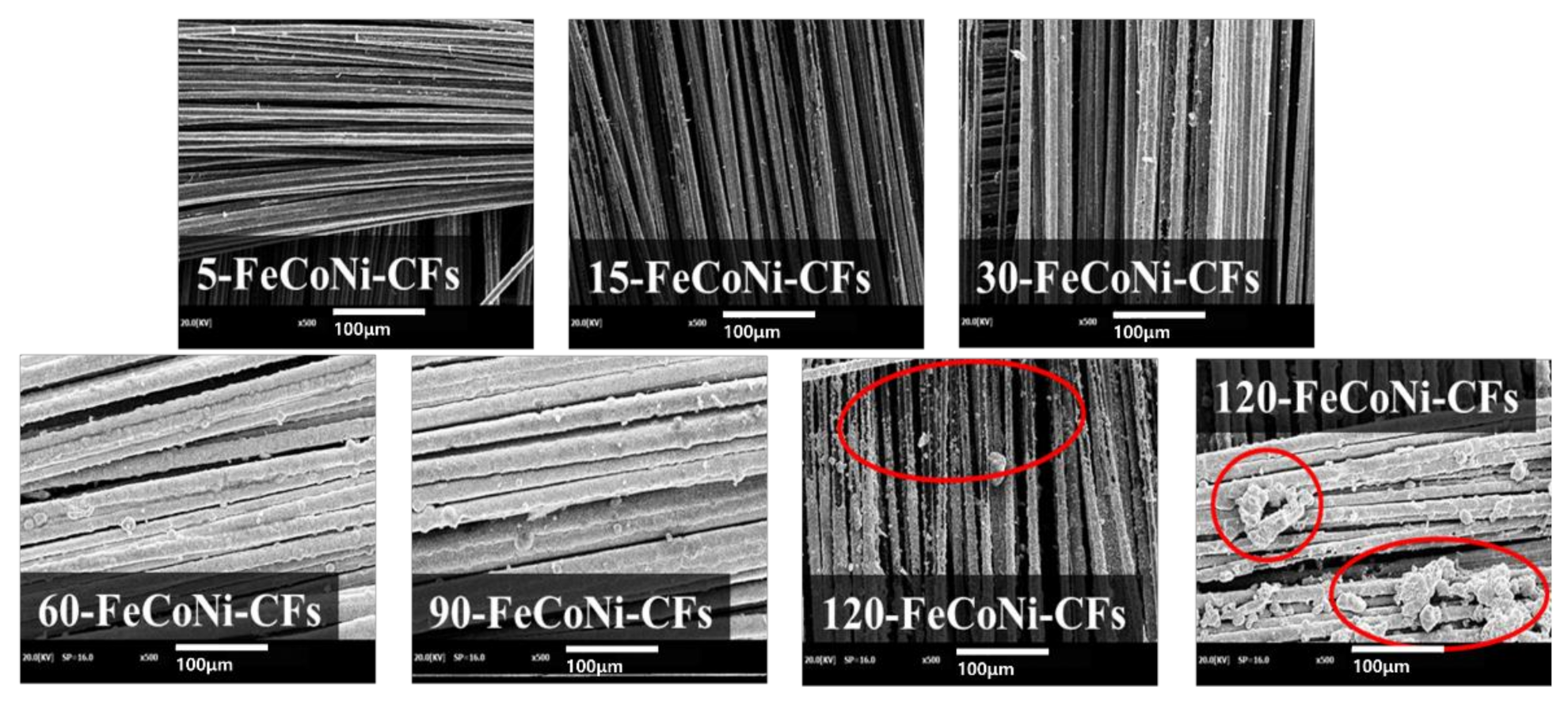
| Type | Carbon Fibers |
|---|---|
| Warp | T300–6000 |
| Weft | T300–6000 |
| Warp density (pc(s)/25 mm) | 10 |
| Weft density (pc(s)/25 mm) | 10 |
| Weave structure | plain |
| Width (cm) | 100 |
| Thickness (mm) | 0.3 |
| Textile weight (g/m2) | 317 |
| Sample | Description |
|---|---|
| as-received CFs | as-received carbon fibers |
| 5-FeCoNi-CFs | 5-min FeCoNi-plated CFs |
| 15-FeCoNi-CFs | 15-min FeCoNi-plated CFs |
| 30-FeCoNi-CFs | 30-min FeCoNi-plated CFs |
| 60-FeCoNi-CFs | 60-min FeCoNi-plated CFs |
| 90-FeCoNi-CFs | 90-min FeCoNi-plated CFs |
| 120-FeCoNi-CFs | 120-min FeCoNi-plated CFs |
Publisher’s Note: MDPI stays neutral with regard to jurisdictional claims in published maps and institutional affiliations. |
© 2021 by the authors. Licensee MDPI, Basel, Switzerland. This article is an open access article distributed under the terms and conditions of the Creative Commons Attribution (CC BY) license (https://creativecommons.org/licenses/by/4.0/).
Share and Cite
Yim, Y.-J.; Lee, J.J.; Tugirumubano, A.; Go, S.H.; Kim, H.G.; Kwac, L.K. Electromagnetic Interference Shielding Behavior of Magnetic Carbon Fibers Prepared by Electroless FeCoNi-Plating. Materials 2021, 14, 3774. https://doi.org/10.3390/ma14143774
Yim Y-J, Lee JJ, Tugirumubano A, Go SH, Kim HG, Kwac LK. Electromagnetic Interference Shielding Behavior of Magnetic Carbon Fibers Prepared by Electroless FeCoNi-Plating. Materials. 2021; 14(14):3774. https://doi.org/10.3390/ma14143774
Chicago/Turabian StyleYim, Yoon-Ji, Jae Jun Lee, Alexandre Tugirumubano, Sun Ho Go, Hong Gun Kim, and Lee Ku Kwac. 2021. "Electromagnetic Interference Shielding Behavior of Magnetic Carbon Fibers Prepared by Electroless FeCoNi-Plating" Materials 14, no. 14: 3774. https://doi.org/10.3390/ma14143774
APA StyleYim, Y.-J., Lee, J. J., Tugirumubano, A., Go, S. H., Kim, H. G., & Kwac, L. K. (2021). Electromagnetic Interference Shielding Behavior of Magnetic Carbon Fibers Prepared by Electroless FeCoNi-Plating. Materials, 14(14), 3774. https://doi.org/10.3390/ma14143774






